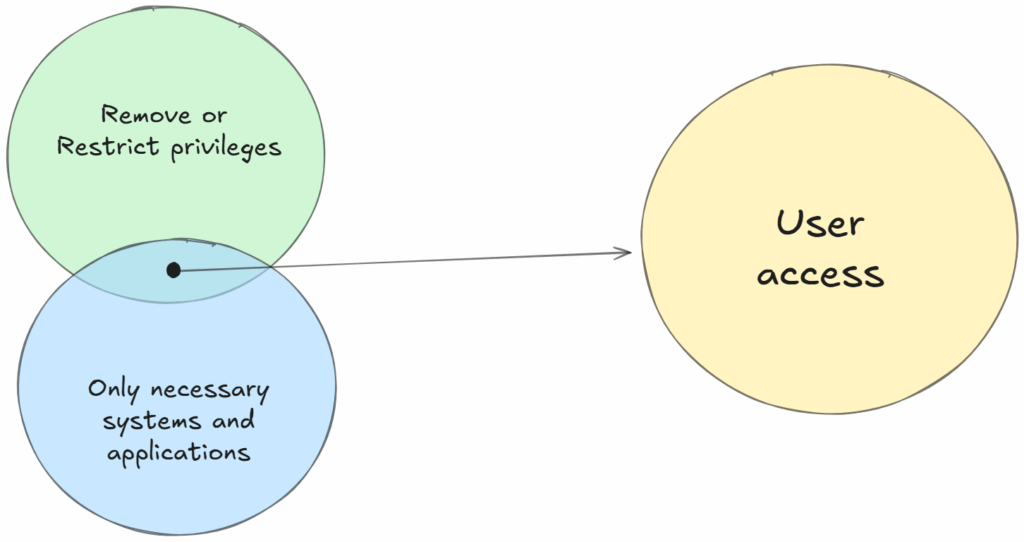In security, more access usually means more risk. The Principle of Least Privilege (PoLP) is about flipping that around, giving users, systems, and apps only the access they truly need, nothing more.
It’s simple in theory but powerful in practice: when people or systems can’t touch what they don’t need, they can’t break it (accidentally or otherwise).
Table of Contents
Why Least Privilege Matters
Most breaches start with too much access.
A user clicks a phishing link, malware runs with their admin rights, and suddenly the whole network’s on fire. If that user had limited access, the damage would’ve been contained to one account or one system. That’s what PoLP prevents, chaos spreading beyond its starting point.
PoLP doesn’t just guard against hackers. It also saves you from insider mistakes and “oops” moments like a user deleting shared folders they shouldn’t have even seen.
And yes, it keeps malware from running wild since it can’t exploit privileges it doesn’t have.
What Privileged Accounts Are (and Why They’re Dangerous)
Not all accounts are created equal.
Privileged accounts have special powers, installing software, managing configurations, running services, or touching sensitive data.
Think of them as the keys to the kingdom. And if those keys get stolen, it’s open season on your infrastructure.
Types of privileged accounts include:
- Admin/root accounts: Control system-wide changes.
- Service accounts: Run background processes and automation.
- Application accounts: Manage specific app functions.
- System accounts: Handle OS-level components.
These accounts need tight control, strong authentication, monitoring, and isolation. That’s where Privileged Access Management (PAM) comes in. It enforces who gets access, when, and how long.

How PoLP Works in Practice
Least privilege isn’t a one-time setup, it’s an ongoing discipline.
- Audit what exists.
Start by finding every account with elevated access—users, vendors, services, cloud apps. Identify what’s overprivileged. - Revoke the excess.
Drop unnecessary admin rights, remove shared accounts, and lock down unused permissions. - Separate duties.
Admins shouldn’t use their everyday login for privileged work. Create split accounts—one for regular use, one for admin tasks. - Grant access only when needed.
Use Just-In-Time (JIT) access so privileges exist only for short periods. When the task’s done, access expires. - Watch everything.
Monitor privileged account activity, set up alerts for odd behavior, and review permissions regularly. - Secure the cloud, too.
Cloud IAM roles are easy to overprovision. Enforce the same least-privilege logic in AWS, Azure, and other platforms.
PoLP isn’t about micromanaging, it’s about containing risk before it becomes a headline.
Real-World Examples
Here’s how least privilege shows up in daily IT life:
- User accounts: An employee who just runs backups doesn’t need access to HR data. Backup rights only, nothing more.
- Endpoint security: Removing local admin rights from regular users blocks 90% of common malware installs.
- Application permissions: Apps should only access the data they need, not the entire database.
- Cloud roles: In Azure or AWS, define roles per job—not per person—and remove blanket “owner” or “admin” assignments.
- Privileged sessions: Keep admin logins separate and audited. Never use a shared “admin” account for daily operations.
Benefits That Actually Matter
Implementing PoLP pays off quickly. Here’s what you’ll notice:
- Smaller attack surface: Fewer paths for attackers to exploit.
- Reduced insider risk: Employees can’t mess up what they can’t access.
- Better compliance: Regulations like HIPAA, GDPR, and ISO 27001 love least privilege.
- Stable systems: Less chance of “oops, I changed a system setting” moments.
- Simpler admin life: Clean role definitions mean fewer helpdesk tickets about permission issues.
- Stronger overall security posture: Because it’s one of the few controls that cuts across every system and app.
Best Practices to Keep It Tight
To make PoLP stick, bake it into your daily IT routine:
- Review access rights regularly. Don’t let old privileges linger.
- Use role-based access control (RBAC) instead of assigning permissions one by one.
- Automate provisioning and deprovisioning. It saves time and prevents forgotten accounts.
- Enforce multifactor authentication (MFA) on all privileged accounts.
- Avoid shared accounts. Everyone gets their own. Accountability depends on traceability.
- Apply PoLP everywhere—users, endpoints, applications, cloud, and infrastructure.
The goal isn’t perfection. It’s making “too much access” the exception, not the default.
The Bottom Line
The Principle of Least Privilege is one of those timeless IT truths:
fewer permissions = fewer problems.
It’s not glamorous, and it won’t earn you applause at the next all-hands meeting.
But when the next ransomware campaign hits and your systems stay safe, you’ll know it was worth it.
Thank you for stopping by. ✌️